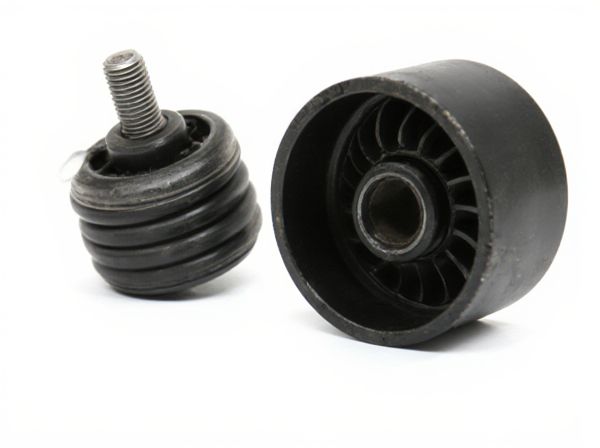
Photo illustration: Worm and Roller vs Worm and Sector
Worm and roller systems provide smooth and efficient motion with minimal backlash, making them ideal for precise applications requiring high stability. Worm and sector mechanisms offer a simpler design, perfect for gears needing quick engagement and disengagement in limited space. Your choice depends on whether precision or compactness is the priority in your mechanical setup.
Table of Comparison
| Feature | Worm and Roller Steering | Worm and Sector Steering |
|---|---|---|
| Mechanism | Worm gear driving a roller that turns the sector shaft | Worm gear directly engaging with a toothed sector |
| Smoother Operation | Yes, due to roller reducing friction | No, typically less smooth due to direct gear contact |
| Durability | Moderate, roller wears over time | High, robust metal-to-metal contact |
| Cost | Higher due to complex roller mechanism | Lower, simpler design |
| Steering Precision | Better precision, reduces backlash | More backlash, less precise |
| Common Usage | Used in passenger cars where comfort matters | Common in trucks and older vehicles |
Introduction to Worm Steering Mechanisms
Worm and roller steering mechanisms utilize a worm gear engaged with a roller to provide smooth, precise control and reduced backlash in vehicle steering systems. Worm and sector mechanisms employ a worm gear that meshes directly with a sector gear, offering robust torque transmission but potentially more play in the steering response. Both designs are essential in automotive steering, with worm and roller favored for enhanced precision and worm and sector valued for its durability and simplicity.
Overview of Worm and Roller System
The Worm and Roller system employs a worm gear meshing with a roller follower, enhancing efficiency by reducing friction and wear compared to the Worm and Sector mechanism, which uses a sector gear segment. This configuration in Worm and Roller drives provides smoother operation, increased durability, and higher torque transmission capabilities, making it ideal for precise motion control applications. Its compact design and superior load distribution contribute to improved mechanical performance in steering and heavy machinery systems.
Overview of Worm and Sector System
The Worm and Sector system employs a worm gear meshing with a sector gear segment, enabling precise angular positioning in steering mechanisms. This design offers simpler construction and cost-effective manufacturing compared to worm and roller setups, making it widely used in automotive steering boxes. The sector gear's partial rotation capacity limits travel range but provides robust torque transmission and durable hardware performance.
Key Components Comparison
Worm and Roller mechanisms utilize a worm gear meshing with a roller, offering smoother motion and higher efficiency due to reduced friction and enhanced load distribution. In contrast, Worm and Sector systems involve a worm gear engaging with a sector gear, providing a simpler design but typically lower efficiency and increased wear. Key components such as the roller in the Worm and Roller setup significantly enhance durability and precision compared to the sector gear in the Worm and Sector arrangement.
Working Principle: Worm and Roller vs Worm and Sector
Worm and roller mechanisms utilize a worm gear engaging with a roller that reduces friction and improves load distribution for smoother motion control. Worm and sector systems employ a worm gear interacting with a sector gear segment, converting rotary motion into controlled angular positioning typically used in steering applications. The worm and roller setup excels in precision and efficiency, while the worm and sector design emphasizes simplicity and robust torque handling in limited angular range.
Advantages of Worm and Roller Steering
Worm and roller steering mechanisms offer enhanced precision and reduced steering effort compared to worm and sector systems, resulting in smoother and more responsive vehicle control. The roller design minimizes friction and wear, increasing durability and lowering maintenance requirements. This setup also provides better feedback to the driver, improving overall driving comfort and safety.
Advantages of Worm and Sector Steering
Worm and sector steering offers a simpler design with fewer moving parts compared to worm and roller systems, resulting in easier maintenance and improved durability. This mechanism provides reliable self-centering and resistance to steering feedback, enhancing vehicle control and driver comfort. Cost-effective manufacturing and effective torque transmission make worm and sector steering advantageous in heavy-duty and industrial applications.
Applications in Automotive Industry
Worm and roller steering gears provide enhanced precision and smoother operation, making them ideal for passenger cars requiring responsive handling and comfort. Worm and sector mechanisms, known for robustness and simplicity, are commonly applied in heavy-duty vehicles such as trucks and commercial vehicles where durability and ease of maintenance are critical. Both types support power steering systems but are selected based on the specific performance and load requirements within the automotive industry.
Performance and Durability Analysis
Worm and roller steering gears deliver superior performance with smoother operation and higher efficiency due to reduced friction between the worm shaft and roller compared to worm and sector designs. Durability in worm and roller systems benefits from improved load distribution and wear resistance, leading to longer service life under heavy-duty conditions. Conversely, worm and sector gears often experience higher wear rates and less precise control, impacting both performance consistency and long-term reliability.
Choosing the Right Steering System
Worm and roller steering systems provide smoother operation and increased durability due to the roller bearing reducing friction, making them ideal for vehicles requiring precise handling and less maintenance. Worm and sector systems offer a simpler design with fewer components, which can be advantageous for older vehicles or applications where cost and ease of repair are prioritized. Selecting the right steering system depends on factors such as vehicle type, desired steering feel, maintenance requirements, and budget constraints to ensure optimal performance and longevity.
 caratoz.com
caratoz.com